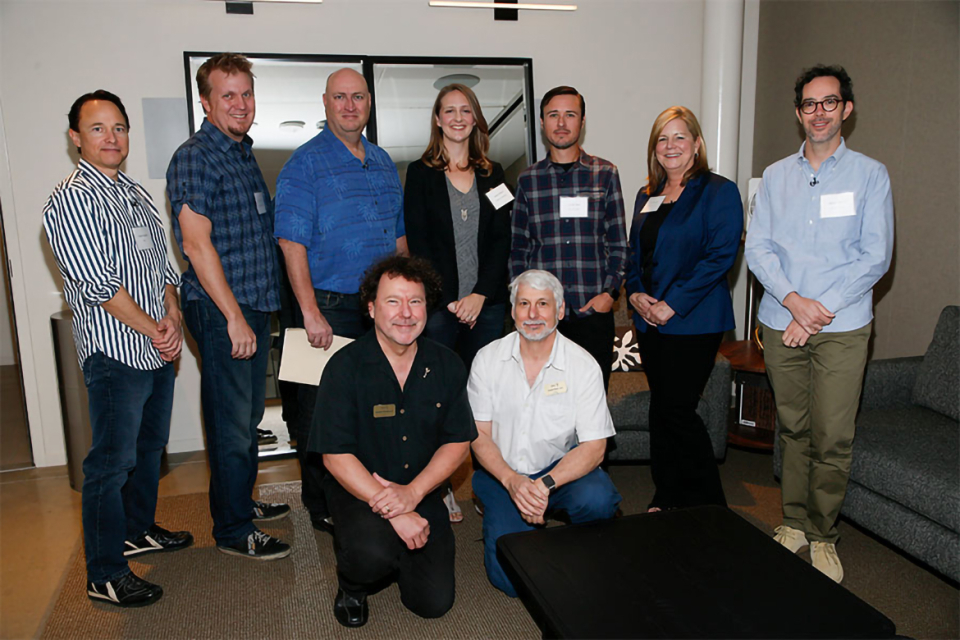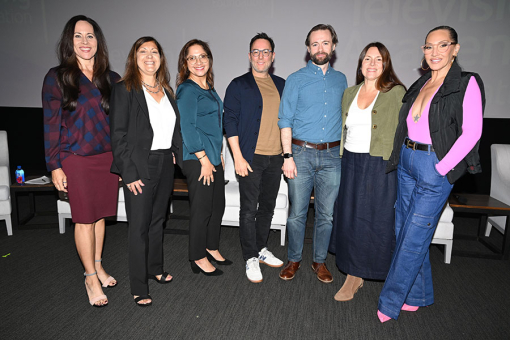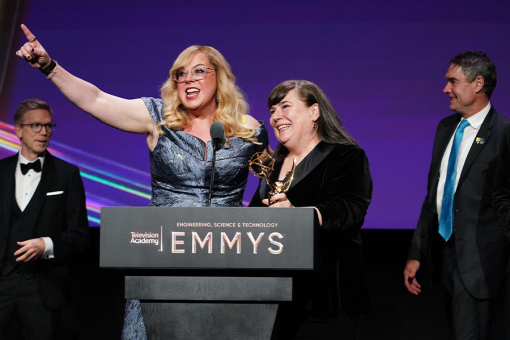In an episode this year of VH1’s reality competition show RuPaul’s Drag Race, drag queen contenders applied make-up in preparation for their “Night of 1,000 Madonnas” runway challenge.
And before the episode was over, contestant Peppermint came out to her competitors as a transgender woman, drawing heartfelt support from all.
Her confession had been building in this, the season’s sixth episode, from a story and character arc established in episode one by lead editor Jamie Martin. Indeed, Martin and his team won an Emmy Award in September for the Drag Race season premiere episode, in the category of Outstanding Picture Editing for a Structured or Competition Reality Program.
“Act one of any first show of a season is the most difficult,” Martin said. “You’re trying to keep the momentum, establish their characters as themselves and in drag. You are establishing the flow of why we should care about these characters, and who they are.”
Martin commented on his job and showed a clip from the confession episode as a panelist during the 2017 Emmy Prime/Cuts event, the 11th annual program spotlighting the art and craft of picture editing presented by the Television Academy and open to the public.
Joining Martin on the panel were Emmy nominees Pat Barnett, ACE, Netflix’s One Day at a Time, multi-camera comedy series category; Jarrod Burt, A&E’s Born This Way, reality programming; Aaron Morris, Comedy Central’s Drunk History, variety programming; Roger Nygard, ACE, HBO’s Veep, single-camera comedy series and Kevin D. Ross, ACE, Netflix’s Stranger Things, single-camera drama series.
Shawn Ryan, executive producer of CBS’s S.W.A.T. and co-creator-executive producer of NBC’s Timeless moderated for the ninth time; picture editors peer group governors Stuart Bass, ACE and Michael Ruscio, ACE welcomed the audience to the Wolf Theatre at the Academy’s Saban Media Center in North Hollywood.
When dealing with a large cast of contenders, Martin said he keeps in mind what a professor had told him about editing dinner table conversations, where it can be difficult to fit in everybody. “I think about how it might not be everyone’s moment to shine [in the scene],” he noted. “And also, that adding funny comments is a way to include everyone.”
Funny comments are a large part of the editing process for Veep’s Nygard. “The show is about a lot of self-involved narcissistic characters insulting each other a lot,” he said. Executive producer David Mandel “tells the writers, ‘You have to go home and write 10 insults per character.’ Then I choose what I like. It’s my sense of humor you get to see.”
It certainly helps to be funny when you’re editing a comedy, One Day at a Time’s Barnett said. And when the show films before a live audience, “what’s interesting is that the writers are on set. If the jokes don’t get laughs, I’ll get different versions.”
Barnett prefers to be involved from the beginning of each episode, attending the table read, run-throughs, any pre-shoots and show night. Norman Lear, executive producer of the original One Day and the current reboot, “is usually there, but he likes to leave us alone for the editing. He’s always our biggest cheerleader when he’s there.”
With the show on a streaming service, episodes run longer than those on network television. “We try to keep them at 26 to 27 minutes, which allows for much more freedom to hang on to stuff you don’t want to lose,” Barnett said. “We film at 35 minutes, but don’t want them to run that long.”
In contrast, the editors at Born This Way, which chronicles young people with Down syndrome and their families, work with “hours of footage,” Burt said. “Because it’s slice-of-life, we never know where it’s going. We may have something in order, and then something will happen in a cast member’s life that’s good, that we put in.”
The show includes interviews with the young adults’ parents. “If there’s a moment you haven’t really captured in a scene, you can pull the families in to talk about it. It may not be scene-related, but topic-related – that’s where the heart comes in.” A clip showing a young woman trying on a bridal gown, for instance, “wasn’t about buying a wedding dress, but about getting married, having a family.
“Our responsibility,” Burt added, “is to tell the story accurately. When you’re editing this subject material with the cast and families, you have to be extra careful and thoughtful. You don’t amp it up. We try to steer clear of drama, to protect them.”
On Drunk History, neither drama nor protecting the cast is on anyone’s mind: the show presents historical anecdotes told by a narrator who has had a few, re-enacted by cast members.
The narrators “truly are drunk,” Morris confirmed. “Your voice changes tempo, your cadence changes. For the first story, they’ve had one or two drinks. Later, it’s eight, nine, ten. We try to be true to the narrator as well as to the story. The producer may have beats in mind, but the narrator may skip over the beats.” They film the narrator at night, and the re-enactments in one day.
As might be expected on this show, the editors have a lot of freedom. But “we never want to force any comedy,” and historical accuracy is still crucial, with total accuracy for names, dates and other details. “We want to treat this like a PBS show where the narrator is drunk,” Morris explained.
For Stranger Things, Ross worked from the show’s Atlanta location for its first three months of filming. “Netflix wasn’t sure what it was going to get,” he said. “Then, after a couple of episodes, I flew back. On location, you have the immediate reaction of the producers, which you don’t get if you’re in Los Angeles and the show is shooting [elsewhere].”
Ross has cut a lot of shows featuring kids, and the young Stranger Things stars, he said, “are on another level. They’re amazing. It’s all about reactions. At the beginning, it was a little harder, as they were getting their sea legs. But then they learned. Each episode offered something new.”
With the sci-fi horror show set in the 1980s, “[Creators] the Duffer Brothers never said, ‘Watch Goonies or E.T.’,” to capture that decade’s style. “It was just the feeling you got when you read it – it feels like Spielberg meets Stephen King. That’s what we felt. We were all on the same page.”
Regardless of the story’s era, Ross uses modern editing options, such as flash cuts. “Now there’s less time to contemplate what you want, but you have more options,” he said. Another change he’s experienced: “What producers expect on your first cut. It had better be network quality. Before, producers would know there is music coming.”
Sound, as it turns out, is crucial to good editing. “I spend as much time on the sound as I do on the picture,” Nygard said. “Especially with comedy, where if you don’t hear it, it’s not funny. I get the sound right first, to know what cuts I want.”
That could mean “massaging out a pause – I want as many jokes as possible every minute. Last season, there was a moment where Selina [Julia Louis-Dreyfus] had to ask her daughter for money. A moment of silence became a punchline.”
During the Q&A, a perennial favorite came up again: How can actors best maximize their screen time and not be cut out?
“Always stay in your scene,” Ross advised. “A lot of times, I’m looking for a reaction, but the actors will say their line and then dead-pan.” Added Nygard, “Don’t say the line and then do hammy pauses.”
And, he said with a smile, “I think the smart actors should really butter up the editors.”











